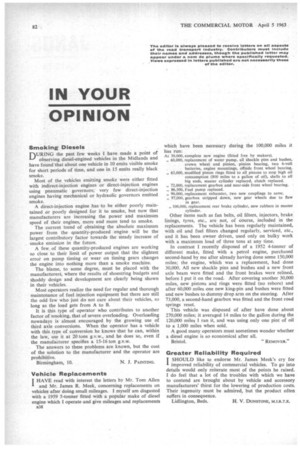IN YOUR OPINION
Page 84

If you've noticed an error in this article please click here to report it so we can fix it.
Smoking Diesels DURING the past few weeks I have made a point of observing diesel-engined vehicles in the Midlands and have found that about one vehicle in 10 emits visible smoke for short periods of time, and one in 15 emits really black smoke.
Most of the vehicles emitting smoke were either fitted with indirect-injection engines or direct-injection engines using pneumatic governors; very few direct-injection engines having mechanical or hydraulic governors emitted smoke.
A direct-injection engine has to be either poorly maintained or poorly designed for it to smoke, but now that manufacturers are increasing the power and maximum speed of their engines, more and more tend to smoke.
The current trend of obtaining the absolute maximum power from the quantity-produced engine will be the largest contributory factor towards the steady increase of smoke emission in the future.
A few, of these quantity-produced engines are working so close to their limit of power output that the slightest error on pump timing or wear on timing gears changes the engine into nothing more than a smoke machine.
The blame, to some degree, must be placed with the manufacturers, where the results of shoestring budgets and shoddy design and development are clearly being shown in their vehicles.
Most operators realize the need for regular and thorough maintenance of fuel injection equipment but there are still the odd few who just do not care about their vehicles, so long as the load gets from A to B.
It is this type of operator who contributes to another factor of smoking, that of severe overloading. Overloading nowadays is almost encouraged by the growing use of third axle conversions. When the operator has a vehicle with this type of conversion he knows that he can, within the law, use it at 20 tons g.v.w., and he does so, even if the manufacturer specifies a 15-16 ton g.v.w.
The answers to these problems are known, but the cost of the solution to the manufacturer and the operator are prohibitive.
Birmingham, 10. N. J. PAINTING.
Vehicle Replacements I HAVE read with interest the letters by Mr. Tom Allen Iand Mr. James R. Meek, concerning replacements on vehicles after doing small mileages. I myself am disgusted with a 1959 5-tonner fitted with a popular make of diesel engine which I operate and give mileages and replacements
B38 which have been necessary during the 100,000 miles it has run:
At 30,000, complete new engine (fitted free by makers).
„ 60,000, replacement of water pump, all shackle pins and bushes, crown wheel and pinion, pinion bearing, two 6-volt batteries, engine mountings, offside front wheel bearing.
„ 63,000, modified piston rings fitted to all pistons to stop high oil consumption (800 miles to a gallon of oil), shells to all big ends, master cylinder replaced, clutch replaced.
„ 72,000, replacement gearbox and near-side front wheel bearing. „ 86,500, Fuel pump replaced.
„ 90,000, replacement exhauster, two new couplings to same.
„ 97,000, gearbox stripped down, new gear wheels due to flaw in gear.
„ 100,000, replacement rear brake cylinder, new rubbers in master cylinder.
Other items such as fan belts, oil filters, injectors, brake linings, tyres, etc., are not, of course, included in the replacements. The vehicle has been regularly maintained, with oil and fuel filters changed regularly, serviced, etc., and it has been owner driven, used only on bulky work with a maximum load of three tons at any time.
In contrast I recently disposed of a 1952 4-tonner of different make, fitted with a petrol engine, purchased second-hand by me after already having done some 150,000 miles; the engine, which was a replacement, had done 30,000. All new shackle pins and bushes and a new front axle beam were fitted and the front brakes were relined, before I put it on the road. After covering another 30,000 miles, new pistons and rings were fitted (no rebore) and after 60,000 miles one new king-pin and bushes were fitted and new bushes to dummy drop arm on the steering. After 73,000, a second-hand gearbox was fitted and the front road springs reset.
This vehicle was disposed of after have done about 270,000 miles; it averaged 14 miles to the gallon during the 120,000 miles I ran it, and was using only one pint of oil to a 1,000 miles when sold.
A good many operators must sometimes wonder whether a diesel engine is so economical after all
Bristol. "REMOVER."
Greater Reliability Required
SHOULD like to endorse Mr. James Meek's cry for I improved reliability of commercial vehicles. To go into details would only reiterate most of the points he raised. I do feel that a lot of the troubles with which we have to contend are brought about by vehicle and accessory manufacturers' thirst for the lowering of production costs. Their ingenuity must be admired, but the product often suffers in consequence.
Lidlington, Beds, H. V. DUNTSTONE, M.I.R.T.E.








































































































































